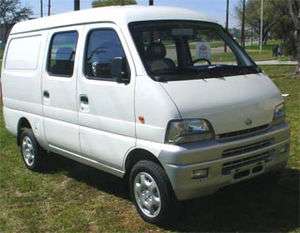Low-speed vehicle
In the United States and Canada, low-speed vehicle (LSV) regulations allow relaxed design and registration laws for four-wheel vehicles that have a maximum capable speed of about 25 mph (40 km/h). Several other countries have similar regulations.

Canada
Under Motor Vehicle Safety Regulations, a low-speed vehicle is defined as a vehicle, other than an all-terrain vehicle, a truck or a vehicle imported temporarily for special purposes, that is powered by an electric motor, produces no emissions, is designed to travel on 4 wheels and has an attainable speed in 1.6 km of more than 32 km/h (20 mph) but not more than 40 km/h (25 mph) on a paved level surface.[1]
France
Quadricycle (EU vehicle classification) are vehicles you can drive without a licence or VSP (voiture sans permit).
Philippines
The Philippines Land Transportation Franchising and Regulatory Board has created a Low-Speed Vehicle category for four--wheeled motor vehicles that use alternative fuel (such as electricity) and have a maximum speed of 40 km/h (25 mph).
This regulation was created for the E-jeepney electric-powered minibuses, which were introduced in 2007. The E-jeepney carries 17 passengers and can run 120 km on an 8-hour charge from an electric outlet.[2][3][4]
United States

The National Highway Traffic Safety Administration has published safety guidelines in the United States which apply to vehicles operating in the 20–25 mile-per-hour speed range.[5] Low-speed vehicles are defined as a four-wheeled motor vehicle that has a gross vehicle weight rating of less than 3,000 pounds (1,400 kg) and a top speed of between 20 to 25 mph (32 to 40 km/h).[6]
States which have specific regulations for LSVs include Alaska,[7] California,[8] Indiana,[9] Iowa, [10] Kansas,[11] Louisiana, [12] Maine[13] Maryland,[14] Missouri,[15] New York,[16] Oregon,[17] Rhode Island,[18] South Carolina,[19] Tennessee,[20] and Utah[21]
Nearly all 50 states allow LSVs, also called NEVs, to drive on their roads where the speed limit is 35 mph or less.[22][23] Either they follow FMVSS500 (25 mph top speed on 35 mph limit roads), or make their own more aggressive law. Because of federal law, car dealers cannot legally sell the vehicles to go faster than 25 mph (40 km/h),[24] but the buyer can easily modify the car to go 35 mph (56 km/h). However, if modified to exceed 25 mph (40 km/h), the vehicle then becomes subject to additional safety requirements.[22]
These speed restrictions, combined with a typical driving range of 30 miles (48 km) per charge and a typical three-year battery durability, are required because of a lack of federally mandated safety equipment and features which NEVs can not accommodate because of their design. To satisfy federal safety requirements for manufacturers, NEVs must be equipped with three-point seat belts or a lap belt, running lights, headlights, brake lights, reflectors, rear view mirrors, and turn signals;[25] windshield wipers are not required. In many cases, doors may be optional, crash protection from other vehicles is partially met compared to other non motorized transport such as bicycles because of the use of seat belts. In 2011, a Time magazine article concluded that the lack of passenger safety protection made most LSVs unfit for city driving, despite their excellent maneuverability.[23]
Short commute vehicles
Short Commute Vehicle (SCV) is a term sometimes used for vehicles that are used for regular trips of 10 mi (16 km) or less. The term "Ultra Small Vehicle" is also used for similar styles of vehicle.[26]
SCVs are faster than 3 mph (5 km/h) — walking pace — and not regulated by other Motor Vehicle Legislation. It would include vehicles regulated under FMVSS500 (USA Low Speed Vehicle Regulation), CMVSS500 (Canadian Low Speed Vehicle Regulation) and certain L-category vehicles (Quadricycle L6 and L7) in the EU. Battery electric vehicles (BEV) are highly suited as Short Commute Vehicles due to their inherent short operating range, however SCVs do not have to be BEVs.
Since 2010, the American Association of Retired Persons and Insurance Institute for Highway Safety have raised concerns about mixed traffic flows including this class of vehicle.[27][28]
See also
- Battery Electric Vehicles
- Golf cart
- Medium speed vehicle
- Neighborhood electric vehicle
- Quadricycles
References
- "Motor Vehicle Safety Regulations". www.tc.gc.ca. Archived from the original on 13 February 2007.
- earthtimes.org, Electric minibuses start commercial operations in Philippines
- manilastandardtoday.com, Enforcers to drive E-jeeps
- Abs-Cbn Interactive, E-jeepneys debut on Manila streets
- http://legis.delaware.gov/lis/lis144.nsf/vwlegislation/SB+17
- 49 CFR § 571.3 - US Code of Federal Regulations Archived 2009-05-05 at the Wayback Machine; "Archived copy". Archived from the original on 2008-10-18. Retrieved 2008-07-18.CS1 maint: archived copy as title (link)
- "Low-Speed Vehicle Access to Roadways". www.energy.gov. Retrieved 3 December 2018.
- http://www.eere.energy.gov/afdc/progs/view_ind.cgi?afdc/5807/0
- http://www.eere.energy.gov/afdc/progs/view_ind.cgi?afdc/5584/0
- http://www.eere.energy.gov/afdc/progs/view_ind.cgi?afdc/5881/0
- http://www.eere.energy.gov/afdc/progs/view_ind.cgi?afdc/5588/0
- http://www.eere.energy.gov/afdc/progs/view_ind.cgi?afdc/5656/0
- http://www.eere.energy.gov/afdc/progs/view_ind.cgi?afdc/5660/0
- http://www.eere.energy.gov/afdc/progs/view_ind.cgi?afdc/5837/0
- http://www.eere.energy.gov/afdc/progs/view_ind.cgi?afdc/5765/0
- http://www.eere.energy.gov/afdc/progs/view_ind.cgi?afdc/6112/0
- http://www.eere.energy.gov/afdc/progs/view_ind.cgi?afdc/5985/0
- http://www.eere.energy.gov/afdc/progs/view_ind.cgi?afdc/5971/0
- http://www.eere.energy.gov/afdc/progs/view_ind.cgi?afdc/5954/0
- http://www.eere.energy.gov/afdc/progs/view_ind.cgi?afdc/5755/0
- http://www.eere.energy.gov/afdc/progs/view_ind.cgi?afdc/5433/0
- "Map: roads on which low-speed vehicles are permitted". www.iihs.org. Retrieved 2017-01-15.
- Saporito, Bill. "Slow Riders. Souped-up golf carts hit the streets", Time magazine, August 22, 2011, p. 52
- "63 FR 33913, June 17, 1998". www.nhtsa.gov. Retrieved 3 December 2018.
- "Low- and medium-speed vehicles". www.iihs.org. Retrieved 3 December 2018.
- Mitchell, William J. (2010). Reinventing the Automobile: Personal Urban Mobility for the 21st Century. MIT Press. p. 178. ISBN 9780262288569. Retrieved 15 December 2018.
- "Policy and Design Considerations for Accommodating Low-Speed Vehicles and Golf Carts in Community Transportation Networks" (PDF). www.aarp.org. Retrieved 13 December 2018.
- Low Speed Vehicles and Minitrucks shouldn't share busy Public Roads with Regular Traffic